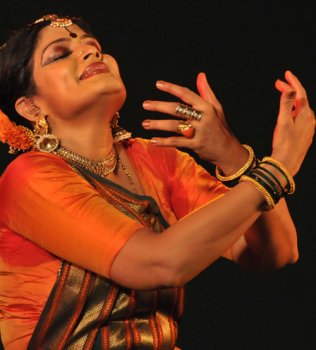
|
 |

|
 |
Geeta Chandran: Aspiring to engage - Shilpi Shukla Alexander November 22, 2010 (This interview 'Aspiring to Engage' first appeared on Sept 13, 2010 in LITTLE INDIA magazine, New York, as part of a complete article 'The Lost Indian Art of Desire' by Shilpi Shukla Alexander for the cover story, Understanding Erotica.) Bharatanatyam dancer Geeta Chandran, who skillfully showcases abstract notions of love, desire, joy, beauty, values, spirituality and myth, says Indian classical dance is the last bastion of erotica in the country today. How do you define eroticism? Eroticism is a luxury when the mere physical needs are fulfilled and the realm of imagination probes for more. Nothing could be more sensual and erotic than the verses of Kalidas where he describes every minute aspect of nature as a celebration of the sensual. In his verses, the man / woman relationship is pitched against the larger creative forces of nature. This way of enjoying the erotic and the sensual was called anavarna - of gradually unpeeling layers, not with the object of revealing, but to enjoy immeasurably the very act of unpeeling. That is the context of old erotica. Is Indian erotica in the past? In India today, classical dance is probably the last bastion of eroticism. That is because dance still celebrates the understated - the coy, the languorous. The shringara (love-themed) dance items all use gesture and nazar (eye movements/expressions) to convey deeper meaning, elaborating key poetry that add subtle shades to erotica. The full range of padams (the most lyrical section where the dancer speaks of some aspect of love) in Bharatanatyam, for example, are built on this premise of anavarna. I have also been taught several precise hand gestures that indicate sex and sexuality. But it was never vulgar, but erotic. What we have today is merely an urge for the linear. It is about baring it all. And in that urge for the here and now, imagination flees and eroticism withers into an unexciting product.  Does this sensuality also extend to other Indian classical dance forms? All the classical dance forms of India approach content in a similar fashion. They all traverse the razor-edge while synthesizing bhakti (devotion) and shringara (the erotic sentiment). The erotic sentiment is accepted in performance, because the underlying metaphor for desire - even physical desire - is understood by both performer and audience as the longing of the human soul for spiritual amalgamation with the universal consciousness. Thus all desires, including the need for the erotic or the physical are sublimated to a different spiritual level. This is ultimately what makes the erotic survive even in a relatively conservative South Asian society. And thus it is that all the classical forms are able to include the erotic in their stage presentations. Not just Kuchipudi and Kathak, but others like Odissi showcase the Geet Govind, which is one of the most erotic texts that have ever been penned in Sanskrit. The deepest devotion for Krishna is presented as a desire for physical consummation with him, and the anavarna of desire is the key leitmotif of Jayadeva's opus verse. Are there Indian fusion dance forms you experimented with which take eroticism beyond where it is in Bharatanatyam? As a purist, I tend to believe that fusion leads to confusion. The classical arts of India require complete solidarity of understanding of the aesthetic by the artist. Fusion takes away the sublimity of the performance and brings on external values of marketability, which even at first take, leads to the death of the erotic. As I said before, the erotic is a slow massaging of the human senses, when the experience embraces the audience in a special moment of a sense-transactional union. Experiments and fusion are market driven and only drive away the erotic impulse. What's the difference between the erotic/sensual and sexual/vulgar? I think the two belong to completely different universes. The erotic is a function of the cyclical while the sexual/vulgar are a function of the linear. The former has no goal or aim, it exists per se. The latter is aimed at an obvious short term gratification of the senses. The two belong to different world views: one where life is a jubilant celebration; the other where life is a possession. In current times, what is the difference between Indian erotic sensibilities as compared to Western understanding of the concept? Let me take my medium of expression, dance. Indian dance uses facial expressions in an elaborately structured fashion. Every inflexion of facial muscles conveys meaning. A delicate arch of the eyebrow, the sudden inflexion of the chin, every minute part of the face and arms and body are used to unveil deeper secrets. The dance is created as an intimate experience for the viewer. At the other end of the visual spectrum, the Western concept of dance has evolved as a body experience, where the experience of the magic is in terms not of the individual been drawn to the dance, but in terms of what is experienced by the audience as a whole. Their aims are different; one aspires to engage, the other to dazzle. Any other difference? Western emphasis is on the body. Again picking the example of dance, by the time a performer is 30 years of age, she is forced to retire to other related professions. The West's notion of beauty is so linked to the supple body that they are inflexible when it comes to the maturing of the body. George Balanchine probably started the trend of size zero dancers in the New York Ballet Company. In India, performers, like wine, mature with age. Mature dancers dance with all their senses and are more alluring as they get more and more experienced. The mere body virtually ceases to be and the dance experience becomes more elaborately sensual and textured. |